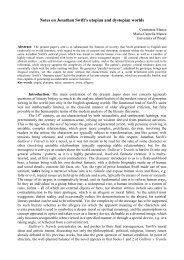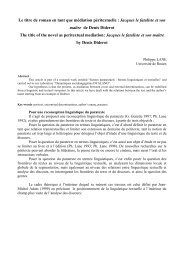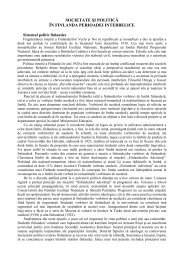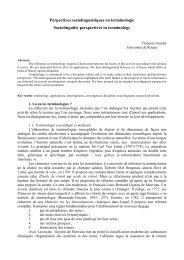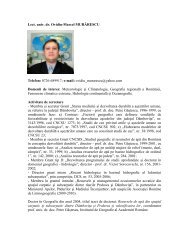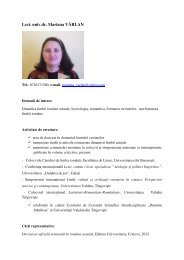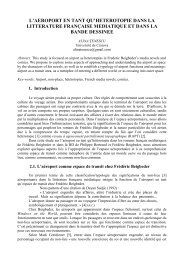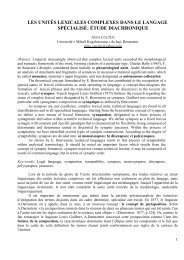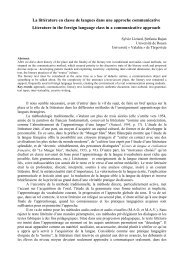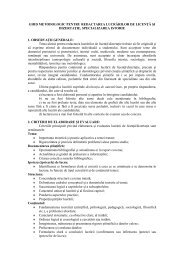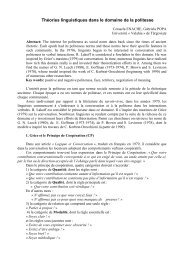THE ANNALS OF „VALAHIA” UNIVERSITY OF TÂRGOVIŞTE
THE ANNALS OF „VALAHIA” UNIVERSITY OF TÂRGOVIŞTE
THE ANNALS OF „VALAHIA” UNIVERSITY OF TÂRGOVIŞTE
Create successful ePaper yourself
Turn your PDF publications into a flip-book with our unique Google optimized e-Paper software.
8<br />
The Annals of „Valahia” University of Târgovişte<br />
The masculine guarantee is able to activate all the codes mentioned above.<br />
Let us exemplify.<br />
The new BCR Campaign makes the masculine guarantee activate the<br />
utilitarian code (the promoted banking services are presented as being useful for the<br />
consumer who is invited to make `banking with BCR`), as well as the sociocultural<br />
one, at the same time: the masculine guarantee appears in more hypostases:<br />
the tennis-man who makes the public be tensioned until it does not know the bank<br />
he is working with.<br />
The mythic code presents us the image of the savior: the bank clerk is able to<br />
bring safety and release to citizens (the image of a couple walking on a rope, or that<br />
of the child running in the street for his ball). The same campaign activates the<br />
commercial code as it sells the product.<br />
Our Romanian advertising activates, under such circumstances, the theory<br />
of cognitive dissonance. It is made use of when the consumer has already made up<br />
his mind and decided what product to choose (he had applied the theory of<br />
learning 6 ) and even more, he wants to be sure that his choice is the best one.<br />
So that, a new procedure is on the point of being done: it is a postbehaviorist<br />
scheme meant to fix his certitude.<br />
The cognitive dissonance was applied especially for those products which<br />
were implying great expenses, or major changes of the life style of the consumer. It<br />
is about those categories of products for whose purchasing the consumer is<br />
seriously involved:<br />
• either because they are very expensive and needs to know on what he is<br />
spending his money (motor-cars, electric or electronic household<br />
appliances, banking or insurance services)<br />
• or because they trigger a great responsibility in the process of purchasing,<br />
for himself or for his family (medicine).<br />
The masculine presence offers credibility to the promoted product. Here<br />
is a brief typology:<br />
• the bank clerk (Transylvania Bank)<br />
• the mechanic (Calgon);<br />
6 Claude Bonnange, the quated work: this theory was formulated during the span of time between<br />
the two World Wars, at a time when very few companies were interested in promoting their<br />
products by means of advertising. As long as competition was not that tough, the people needed<br />
only to be informed, not to be persuaded as well. So that, the role of advertising was strictly<br />
informative. The first companies who made use of this theory of learning were the producers of<br />
cleaning staff: PROCTER&GAMBLE, COLGATE, LEVER. They even created a so-called `code<br />
of thinking`, a certain `creative strategy` made up of three main steps: the promise (our product<br />
can whiten your clothes better than other abluent can do), the benefice (you will get stainless<br />
clothes, result which you could not get so far) and the proof (the testimonial of the beneficiary).<br />
These three steps were supposed to be accompanied by an informative and new tone, attentive to<br />
the promoted event. But very soon, all the producing companies started to take benefit of the<br />
advantages of technology. The consequence was that they were all bringing the same benefits to<br />
the consumer, their products were alike. Under such circumstances, this theory was dangerous to<br />
be used any longer by the producing companies.




